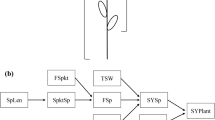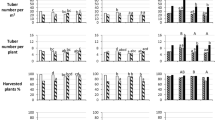Abstract
Two generations of recurrent phenotypic selection for seed yield per plant under controlled pollination were carried out to combine improved seed yield with improved forage grass performance in perennial ryegrass (Lolium perenne L.). Selected and unselected varieties (AberDartand AberElan respectively) and control varieties were grown for seed in pots in a glasshouse experiment and in two field plot experiments over 5 harvest years. Seed yield components and seed yield were measured. Significant improvements in seed yield of the selected AberDart over the unselected AberElan were observed both in individual plants grown in the glasshouse and in field plots. Detailed observations of the individual components of seed yield showed that the increased seed yield of AberDart can be attributed to a higher proportion of ovules forming seeds (% seedset), greater seed number per tiller and more reproductive tillers per plant. This improvement in seed yield of AberDart was also observed when it was grown in field plots with AberElan, experimental selection lines and commercial varieties. AberDart produced more seeds per tiller than the other commercial varieties and selection lines studied. The implication of this approach for the breeding of perennial ryegrass varieties that combine good agronomic performance and acceptable seed yields is discussed.
Similar content being viewed by others
References
Baird, D.B., S.A. Harding, P.W. Lane, D.A. Murray, R.W. Payne & D.M. Soultar, 2000. GenStat for Windows (6th Edition), Introduction. VSN International, Oxford.
Bugge, G., 1987. Selection for seed yield in Lolium perenne L. Plant Breed 98: 149–155.
Dunnett, C.W., 1955. A multiple comparison procedure for comparing several treatments with a control. J Amer Stat Assoc 50: 1096–1121.
Elgersma, A., 1990a. Genetic variation for seed yield in perennial ryegrass. Plant Breed 105: 117–125.
Elgersma, A., 1990b. Spaced-plant traits related to seed yield in plots of perennial ryegrass (Lolium perenne L.). Euphytica 51: 151–161.
Elgersma, A., G.D. Winkehorst & A.P.M. Den Nijs, 1994. The relationship between progeny seed yield in drilled plots and maternal spaced-plant traits in perennial ryegrass (Lolium perenne L.). Plant Breed 112: 209–214.
Hebblethwaite, P.D., 1977. Irrigation and nitrogen studies in S23 ryegrass grown for seed 1. Growth, development, seed yield components and seed yield. J Agric Sci 88: 605–614.
Humphreys, M.O., 1994. Variation in the carbohydrate and protein content of ryegrasses: potential for genetic manipulation. In: D. Reheul & D. Ghesquiere (Eds.), Breeding for Quality, pp. 165-172. Proc 19th EUCARPIA Fodder Crops Section Meeting, Brugge, Belgium, 5-8 October 1994. EUCARPIA, Wageningen, The Netherlands.
Humphreys, M.O., L. Miller & J. Moorby, 2001. Breeding high quality forage for sustainable dairy farming-a multidisciplinary approach. Irish Grassld and Animal Prod Assoc J 34: 62–69.
Marshall, C. & D. Ludlum, 1989. The pattern of abortion of developing seeds in Lolium perenne. Ann Bot 63: 19–27.
NIAB, 2002. Recommended varieties of grasses and herbage legumes 2002/2003. NIAB, Cambridge UK.
Payne, R.W. (Ed.), 2000. The Guide to GenStat, Part 2: Statistics. Section 5.7, VSN International, Oxford.
Rowarth, J.S., 1997. Nutrient and moisture inputs for grass seed yield. J Appl Seed Prod 15: 103–110.
Seka, D. & H.Z. Cross, 1995. Xenia and maternal effects on maize kernel development. Crop Sci 35: 80–85.
Snedecor, G.W. & W.G. Cochran, 1980. Statistical Methods, 7th Edn. pp. 96-98. Iowa State University Press, USA.
Wijk, A.J.P. van, 1980. Breeding for improved herbage and seed yield in Setaria sphaecelata (Schumach.) Stapf and Hubbard ex Moss. Agricultural Research Report 900, Pudoc, Wageningen.
Wilkins, P.W., 1995. Independence of dry matter yield and leaf yield among perennial ryegrass varieties differing in seasonal yield distribution. Grass and Forage Sci 50: 155–161.
Wilkins, P.W. & R.W. Davies, 1994. Progress in combining high dry matter yield with reduced flowering and improved digestibility in perennial ryegrass. In: D. Reheul & D. Ghesquiere (Eds.), Breeding for Quality, pp. 247-252. Proc 19th EUCARPIA Fodder Crops Section Meeting, Brugge, Belgium, 5-8 October 1994.
Wilkins, P.W., D.K. Allen & L.R. Mytton, 2000. Differences in the nitrogen use efficiency of perennial ryegrass varieties under simulated rotational grazing and their effects on nitrogen recovery and herbage nitrogen content. Grass and Forage Sci 55: 69–76.
Young, W.C. III, D.O. Chilcote & H.W. Youngberg, 1995. Seed yield responses of perennial ryegrass to spring applied nitrogen at different rates of paclobutrazol. J Appl Seed Prod 13: 10–15.
Author information
Authors and Affiliations
Rights and permissions
About this article
Cite this article
Marshall, A., Wilkins, P. Improved seed yield in perennial ryegrass (Lolium perenne L.) from two generations of phenotypic selection. Euphytica 133, 233–241 (2003). https://doi.org/10.1023/A:1025593808010
Issue Date:
DOI: https://doi.org/10.1023/A:1025593808010




